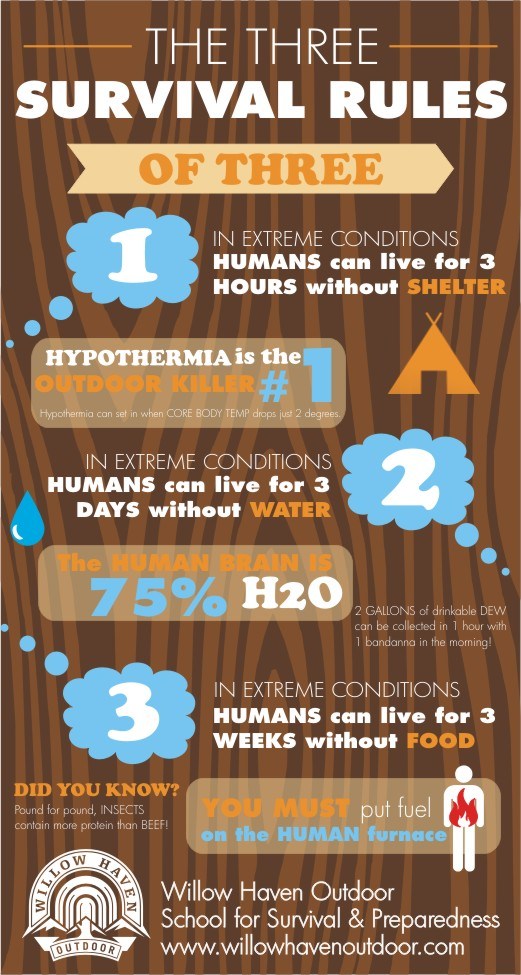The Rule Of 3: Survival Edition
Knowing and having outdoor survival skills helps people survive in the unfortunate event that they get lost or injured in the woods or are the survivor of a natural disaster. But for those with limited survival skills and who also enjoy spending time in the outdoors, knowing the most basic survival rule of 3 will go a long way in helping prioritize survival needs.
For survival situations its best to remember AND prioritize the four levels of the Survival Rules of 3:
- You can survive for 3 Minutes without air
- You can survive for 3 Hours without shelter in a harsh environment
- You can survive for 3 Days without water in a harsh environment
- You can survive for 3 Weeks without food in a harsh environment

Rule # 1 – AIR
You have to breathe. Your body needs oxygen. Someone who is not breathing has only minutes… So, priority #1 is air. Try holding your breath. Not many people can hold their breath for 3 minutes or more. The science behind this is that without oxygen your body, and most importantly, your brain will stop functioning. Within about 3 minutes, your brain cells start to die and your brain, as well as your other organs, will start to shut down. So get to a place where you can breathe.
Rule #2 – SHELTER
Next on this list of priorities is to build a shelter to prevent exposure in extreme weather conditions. Your body works best at around 98.6°F (37°C). The more you stray from the ideal body temperature, the more likely you have a chance of succumbing to the elements. The number one cause of death of persons lost in the wilderness is either due to hypothermia (cold) or hyperthermia (overheating). And it doesn’t take much of a temperature change to make a difference. Did you know that you could suffer from hypothermia at 50 degrees, especially if it is windy and wet? In warmer climates, you will need shelter from the heat and radiation of the sun. Along with building a shelter, you should carry the mentality of the Law of 3 when packing for your hike. If you’re going to have a kit of some kind, have 3 means of fire starting. Outside of lighters and matches, some of your best fire-starting options are:
- flint & steel
- magnesium stick
- fire stick
- magnifying lenses
- car battery and steel wool
Rule #2 – WATER
The second leading cause of death of people lost in the wilderness is dehydration. Roughly 60% of your body is water, which is used to process food, eliminate waste as well as cool your body. Dehydration from lack of water alone or combined with profuse sweating or even diarrhea can kill you with 3 days. When water is scarce, avoid activity that leads to lots of sweating and heavy breathing. Whether you are working hard or conserving by just sitting still, your body will need water.
The general rule of thumb is that one gallon of water is required per person per day for drinking and basic sanitation. But water is often contaminated by microscopic pathogens which can cause severe sickness and in some cases, death. If there is no access to clean, potable water, you will need to purify it. The easiest and most common way to achieve purified water is to heat it until it boils for 2-3 minutes to kill any bacteria and viruses that you may have scooped up. If you are not near a fire or have access to manual filtering pumps, be sure to have iodine tablets handy as a backup.
Rule # 3 – FOOD
Food is last on the list of survival. Depending on your body fat, overall health and the levels that you exert yourself, you can potentially survive longer than 3 weeks without food. However, it is better to obtain as many calories as possible to maintain proper body function properly. Some of us will survive even longer without it, but food will become an urgent concern for survival after a couple of weeks. With plenty of water, some can even survive longer than three weeks, but you will want to locate a source of nourishment while you still have the strength to do so.
The Rule of 3
The rule of three is a principle that states that individuals can survive for three minutes without air, three hours without shelter, three days without water, and three weeks without food. In a survival situation, it is important to focus first on securing a safe environment, obtaining clean air, and finding a reliable source of water. From there, you can work to find food and other resources to sustain their lives over the long term. By following the rule of three, you can increase their chances of survival in a crisis.
